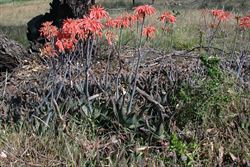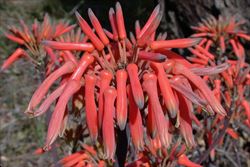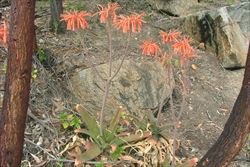Click on images to enlarge

infestation near a roadside (Photo: Rob and Fiona Richardson)

infestation on a rocky clifftop (Photo: Sheldon Navie)

habit in flower (Photo: Rob and Fiona Richardson)

habit prior to flowering (Photo: Sheldon Navie)

the broad, spotted, fleshy leaves and thick flowering stem (Photo: Rob and Fiona Richardson)

branched flower clusters (Photo: Sheldon Navie)

close-up of reddish-orange tubular flowers (Photo: Rob and Fiona Richardson)

immature fruit (Photo: Sheldon Navie)

habit of Aloe striata x maculata (Photo: Sheldon Navie)

habit of Aloe parvibracteata (Photo: Sheldon Navie)

habit of Aloe greatheadii (Photo: Sheldon Navie)

leaves of Aloe zebrina (Photo: Sheldon Navie)
Scientific Name
Aloe maculata All.
Synonyms
Aloe latifolia Haw.
Aloe perfoliata L. var. saponaria Ait.
Aloe saponaria (Ait.) Haw.
Aloe saponaria (Ait.) Haw. var. saponaria
Aloe saponaria (Ait.) Haw. var. ficksbergensis Reynolds
Family
Aloeaceae (Victoria, Tasmania and the Northern Territory)Asphodelaceae (Queensland, New South Wales and Western Australia)Liliaceae (South Australia)
Common Names
African aloe, aloe, broad leaf aloe, broad-leaf aloe, broadleaf aloe, broad-leaved aloe, common soap aloe, flecked aloe, spotted aloe, soap aloe, yellow soap aloe, zebra aloe
Origin
Native to Southern Africa (i.e. South Africa, Lesotho and Swaziland).
Naturalised Distribution
This species is widely naturalised in south-eastern and eastern Australia (i.e. in south-eastern Queensland, in some parts of central and northern New South Wales, in southern and western Victoria and in Tasmania). Also naturalised on Lord Howe Island, Norflok Island and sparingly naturalised in south-eastern South Australia.
Broad-leaf aloe (Aloe maculata) is occasionally also recorded as a garden escape in south-western Western Australia, but it is not yet regarded as being fully naturalised in this region.
Notes
Broad-leaf aloe (Aloe maculata) is a moderately common environmental weed in south-eastern Australia. It is also seen as a minor weed or "sleeper weed" in other parts of the country. This succulent plant is widely cultivated as a garden ornamental and often becomes established in bushland after being dumped in garden waste.
In its native habitat of southern Africa, broad-leaf aloe (Aloe maculata) grows in open grassy places and on exposed rocky slopes that are characterized by a cool climate. In Australia, it invades dry coastal vegetation, mallee shrublands, lowland grasslands, grassy woodlands, dry sclerophyll forests, and saline and subsaline wetlands.
Broad-leaf aloe (Aloe maculata) is currently of most concern in Victoria, where it is thought to pose a serious threat to one or more vegetation formations. This invasive succulent is listed as an environmental weed by several local and regional authorities in this state (e.g. in the City of Hume, the Mornington Peninsula Shire, the North Grampians Shire, Swan Hill Rural City, Banyule City and the Goulburn Broken Catchment). It is also regarded as an important environmental weed in French Island National Park and has been recorded in Yarra Bend Park in suburban Melbourne.
In South Australia, broad-leaf aloe (Aloe maculata) is a problem in coastal dunes in the Adelaide Metropolitan area. It has also been recorded in conservation areas near Adelaide (i.e. Onkaparinga River Recreation Park and Para Wirra Recreation Park). In New South Wales, it has been occasionally recorded it the Tamworth and Sydney districts. However, it may also be naturalised on the south coast and in the Great Lakes Shire on the central coast (i.e. it is listed as a weed in Burgess Road Reserve).
Note: There are numerous aloe species and hybrids with spotted leaves, some of which are also cultivated and naturalised in Australia (e.g. Aloe parvibracteata and Aloe striata x maculata). These species may be easily confused with spotted aloe (Aloe maculata), and their naturalised distributions may therefore be under-represented.

